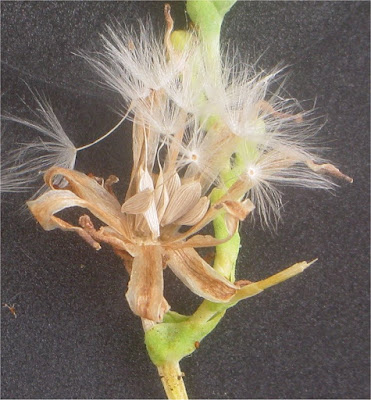 |
| How to grow lettuce from seed |
You can't beat the flavour and crisp texture of a freshly grown lettuce, and truth be told, you can't buy that in the supermarkets. Why? Because commercial grown lettuce first have their roots cut when they are harvested so they immediately begin to lose moisture and therefore crispness from its leaves. Next, they are placed into an enormous vacuum cooler to remove the field heat from the lettuce and later are placed in a refrigerated cool transportation chain until they reach the store.
The best way to avoid all of this deterioration in quality is to grow lettuce from seed yourself. And as far as edible crops go, you can't get it any easier.
SOWING INDOORS OR UNDER GLASS
 |
| How to grow lettuce from seed |
If you are without a heated greenhouse and you want to get off to an early start, you can sow your lettuce seed indoors. They will grow quickly, so you may wish to skip sowing them into seed trays and plant them directly into small pots or compartmentalized packs. Just make sure that you use containers that are large enough for the young plants to reach garden size without the need for potting on.
Fill your tray or container with John
Innes seed and potting mix to within a half-inch of the rim, tapping them on the side to help settle the mix. Top up as necessary. If using pots or cells, place a few seeds into each one, and then give a light covering of compost, firming it down gently over the seeds.
If you are using a seed tray then give a light and even sprinkling of seeds across the whole tray at approximately 5 seeds per square inch. Once completed, give a light covering of compost and water in. Label with the variety and date of sowing, and place in into a covered propagator making sure the vents are fully open.
Now leave in a bright, warm room, out of direct sunlight. The more light the seeds receive the better germination you will get. Once the seedlings reach about 2 inches in height, thin out and discard any that look weak. Those in the seed tray can be pricked out and potted on into a standard potting mix. Those already in pots can be hardened off in preparation for moving outside.
.
If your seedlings were grown under glass then they will also need to harden off before going outdoors. Place them into a cold-frame but keep the lid closed for a couple of weeks. Afterwards the lid can be opened on dry frost free days but remember to shut it again at night. After a further week or so, or when frosts are no longer expected, leave the lid open day and night for a week before planting outside.
.To harden off seedlings that have been grown indoors in a heated room, moved them to a bright unheated room, leaving them there for a couple of weeks before either putting them into a cold frame, or for leaving them outside during the day. Never leave them out overnight, and keep them in if there are
strong cold winds of if temperatures drop below 6 degree Celsius. Keep this up for a week and if there is no immediate threat of further frosts they can be planted outside.
.
SOWING OUTDOORS
 |
| How to grow lettuce from seed |
Lettuce plants require a free draining, humus rich soil that is able to hold plenty of moisture in the summer. To prevent the common physiological disorder of 'Tip burn' that can be experienced with some soils, you may wish to add lime before planting.
In preparation to sowing, dig over the soil and add plenty of compost (such as leaf mould or well-rotted manure) during the autumn or early winter. Then a week or so before sowing your lettuce seed rake the soil over to produce a fine
tilth.
You may also wish to apply a general fertiliser at this time.
Although lettuce plants like plenty of light they do not like extremes of heat as this can also result in 'Tip burn'. Although early seeded plants should be fine it's advisable to plant your summer harvest in a lightly shaded site.
When sowing spring lettuce seeds directly outside, wait until the worst of the frosts are over. Choose a sunny site but by sowing seeds this early you may need to give them the protection of a small polytunnel.
If you are starting them off into seed beds, sow the seeds very thinly in ½ inch deep drills but leave about 6 inches between each row.
If you are sowing lettuce seeds directly into the open ground then leave between 10 and 12 inches between rows. To avoid having a glut of lettuce and to ensure that crops are regularly coming into harvest, make successive, smaller applications of lettuce seeds, at 1 or 2 week intervals depending on how much you intend on using.
Depending on the variety it can take any time between 6 and 14 weeks for seedlings to become ready for harvest, so if you are growing from packet seeds - always read the label.
Once the seedlings get to about 2 inches high they can be thinned out to leave a gap of about 6 to 12 inches between each plant- depending on the overall size of the variety grown. If you are planning on transplanting seedlings grown indoors into open ground then this is an ideal time to do this.
Main image - Mahlum public domain
In text image - By Rasbak - Own work, CC BY-SA 3.0, https://commons.wikimedia.org/w/index.php?curid=974775
For related articles click onto the following links:
BBC Lettuce
GROWING ROCKET FROM SEED
HOW TO GROW LETTUCE INDOORS
HOW TO GROW LETTUCE OUTSIDE
HOW TO COLLECT AND PREPARE LETTUCE SEEDS FOR PROPAGATION
HOW TO CONTROL FLEA BEETLES ON LETTUCE
HOW TO GROW AMARANTH FROM SEED
HOW TO GROW LETTUCE FROM SEED
HOW TO GROW ROCKET FROM SEED
HOW TO GROW WINTER LETTUCE FROM SEED
ORGANIC CONTROL OF APHIDS ON LETTUCE

































